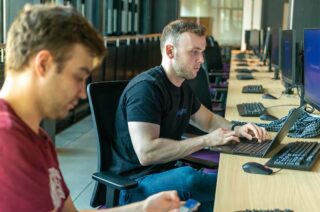Video creation with ExplainEverything – A simple equation

Creating video for teaching and learning does not have to be complicated or time consuming to be effective. With a good plan and the right equipment you could produce some simple introductory videos similar to the ones produced by Dr Louise Walker, Associate Vice-Dean for Teaching and Learning within the School of Mathematics.
The Project
This project was outlined around the aim to create 6 short videos as examples in which Louise could explain the process of working through linear algebra equations for the Blackboard course MATH10202. With these videos and other material in this course, learners would gain an introduction to fundamental concepts within linear algebra, allowing them to apply this knowledge at a later date. Video use within the school had proven popular with learners and so Louise contacted the eLearning team to explore the options available to her in producing her own. Methods and equipment were discussed and Louise chose to take to the tablet to create her clips. Using the app ExplainEverything on a tablet loaned from the eLearning team, Louise could independently create her videos in a simple yet effective way.
ExplainEverything has similar functions to an interactive whiteboard and allows for material to be created from scratch or adapted from imported documents, whilst recording sound and motion on the screen. For the videos in this project, PDF files of the equations were uploaded on to the app and Louise simultaneously used the recording, drawing and moving tools to break down the equations in to stages. The videos needed very little editing and have been embedded into the Blackboard unit, to be released to learners throughout semester 2.
Why video can support learning
The use of video in this way, to give example or direction, can be particularly effective in supporting learning. Richard Mayer (2009) describes 8 Multimedia Design Principles that best support learning, some of which include, The Spatial Contiguity, Multimedia, and Redundancy Principles.
Louise’s commentary alongside the visually imagery when drawing on the screen, combines the use of words and pictures and align with the Mayer’s multimedia principles. Breaking down the tasks and equations into short manageable chunks, or weekly examples in this case, supports the segmenting principle and can help processing capacity in the working memory.
Learner Feedback:
As the learners are still to receive some of the videos, we are yet to discover how effective this cohort has found the resources, however learners’ views will be followed up at the end of the semester.
Feedback from the Tutor:
“I chose to use videos because I wanted to provide extra worked examples for the learners and felt this would be more useful if they had a running commentary that explained the steps in more detail. I know a couple of other members of staff in the School who have produced videos and this has proved popular with learners.”
“I found Explain Everything really easy to use and the videos only took a few minutes to produce. I had help uploading the videos from the eLearning Team but I should be able to do this myself in future. I intend to create more videos next year for my second year course unit.”
Further reading on using multimedia:
- Mayer R. E. (2009) Multimedia learning. Cambridge: Cambridge University Press.
If you are interested in exploring multimedia design in your course or would like support to create and embed videos into Blackboard, please make an enquiry to elearning@manchester.ac.uk.


